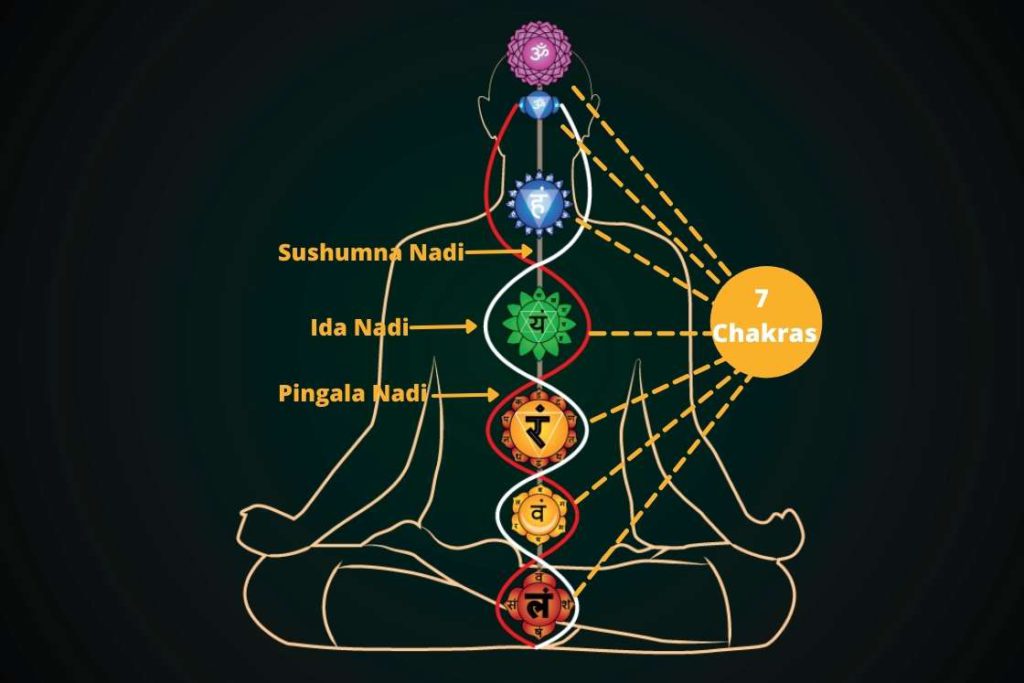
Anulom Vilom is a breathing exercise, or pranayama, practised to improve focus and calm the mind in yoga.
It involves breathing through the left and right nostrils in an alternate manner: Firstly we inhale completely from the left nostril while closing the right one, then close the left nostril and exhale through the right nostril. Breathing in this alternate process is then reversed and repeated.
Anulom Vilom is a form of alternate nostril breathing because while doing this pranayama both nostrils actively participate in the process one after another. You breathe in or out from one side at a time.
The process of doing Anulom Vilom Pranayama itself can be illustrated by its words meaning.
Anulom means “with the grain” or “in natural direction” and Vilom means “against the grain” or “in reverse order”. It implies that in Anulom Vilom pranayama Anulom is a process of inhalation through one nostril and Vilom is a process of exhalation through another nostril, produced in reverse order.
keep on reading to know the right procedure, benefits, and working of Anulom Vilom pranayama.
Step-by-step Instructions

Before doing Anulom Vilom one can do a few rounds of simple deep breathing as a warm-up for the lungs.
It’s recommended practice Anulom Vilom empty stomach preferably in the morning, however if not, it can be done anytime provided it’s been 4 hours since you’ve taken a full meal.
Follow the steps below to practice Anulom Vilom:
- Start with sitting in a comfortable posture, spine straight, shoulder rolled back and eyes closed. You can choose to sit in a meditation position.
- Make Vishnu Mudra with your right hand by bending your middle and index fingers towards the palm while keeping the ring, little finger and thumb straight. The left hand can be kept resting on the left kneecap or in Gyan Mudra.
- Raise your right hand to the nose tip, elbow pointing outward straight to the right.
- Close the tip of the right nostril with your thumb and take a deep breath in from your left nostril for 4 counts. Feel the air flowing through the left nostril to the lungs.
- Now close the left nostril by ring and little fingers and release the thumb from the right nostril to exhale completely for 8 counts.
- With your left nostril close, after complete exhalation, inhale deeply through your right nostril for 4 counts.
- Close right nostril, release ring and little fingers and exhale through the left nostril for 8 counts.
- This completes one round of Anulom Vilom breathing.
One round of Anulom Vilom breathing includes inhaling through the left (4 counts) + exhaling through the right (8 counts) + inhaling through the right (4 counts) + exhaling through the left (8 counts).
In this way, by doing Anulom Vilom for 1 minute you will complete 2.5 rounds. Initially, you can practice it for 10 to 12 rounds which roughly will take 5 minutes at one time.
You may do Anulom Vilom multiple times a day: morning, noon and evening. To reap optimum benefits, aim to practice it for at least 30 minutes daily (including all sessions) for a month. After practising it consistently for a month, increase your time by 10 minutes per session.
Breathing Ratio
The normal breathing ratio in Anulom Vilom should be 1:2 i.e. if inhalation is 4 counts then exhalation should be 8 counts. However, if it’s not comfortable exhaling for 8 counts, a beginner may reduce the counts but the ratio should always be the same.
Traditionally in some yoga texts, Anulom Vilom is instructed incorporating breath retention between inhale and exhale. In that case, the breathing ratio is 1:4:2. So, 4 counts inhalation, 16 counts retention, and 8 counts exhalation.
Again, the count of the breathing may be increased or decreased according to the expertise and lung capacity of a person, but it always should be in a ratio of 1:4:2.
Precautions and contraindications
The practise of Anulom Vilom pranayama is safe for all, however, in some conditions, one should consider taking precautions:
- Pregnant ladies and people suffering from high blood pressure, anxiety, or panic attacks should keep the pace of breathing relatively slow and not hold their breath at any point.
- If you have any kind of heart disease consult your doctor before practice and take guidance in person from an expert yoga teacher.
- People with arthritis or any other joint problem can practice this breathing exercise sitting on a chair instead of sitting cross-legged.
- Do not continue this breathing exercise if at any point you feel dizziness, breath shortness or lightheadedness.
Anulom Vilom Pranayama Benefits

Practising Anulom Vilom for 10 to 15 minutes in the morning yoga session can help you increase your awareness throughout the day. It clears the physical, mental and emotional blockages for better circulation of air in the body.
When practised in the evening, Anulom Vilom may help relax the sympathetic nervous system – which controls your fight or flight response – which in turn can help you better sleep at night.
Scientific evidence proves that practising Anulom Vilom positively impacts your cardiovascular system, respiratory system, nervous system, and brain. It increases your concentration and oxygen level in the body.
Here are five evidence-based benefits of Anulom Vilom pranayama:
1. Improves respiratory system and clears blockages
Anuloma Vilom improves lung strength and can be utilized to treat respiratory problems such as asthma and allergies. It helps fight infections that can lead to serious issues like bronchitis or chest infections. It clears the congested nostrils which can aid individuals who suffer from snoring or sinus issues.
In a 2017 study conducted on 27 national and international competitive swimmers of the age range 13–20 years, it was successfully noted that yogic breathing exercises such as Anulom Vilom significantly enhanced respiratory endurance.
A paper published in 2013 was successful in noting that 30 minutes of Anulom Vilom practice worked as a catalyst in treating rhinosinusitis, or sinus inflammation.
2. Alleviate stress and improve the quality of sleep
Anulom Vilom pranayama has a relaxing impact on the brain that decreases stress and enhances mental wellness. It helps to manage stress and improve mental wellbeing.
It has been shown in a 2017 study, Anulom Vilom helps stress-related conditions like anxiety and mood swings by balancing the sympathetic and parasympathetic nervous systems. The practice prevents negative thoughts from entering the mind and promotes optimistic thinking thus preventing symptoms of depression ad anxiety.
With a calm and stress-free mind, you can also benefit from improved quality of sleep and enhanced relaxation.
Many individuals like to do Anulom Vilom in the morning before they start their day since it helps them get into a good mood.
3. Strengthens and maintains the cardiovascular system
Anulom Vilom modulates blood pressure and nourishes the veins and nerves throughout the body. It can help treat BP-related conditions like heart blockages, hypertension, and diabetes.
Daily practice of Anulom Vilom can protect us from heart attacks, cardiac arrests, and an increase in bad cholesterol by preventing artery obstruction, rendering arteries cleaner, and increasing blood flow.
It increases the heart’s performance by maintaining healthy and continuous blood circulation throughout the body.
A 2013 paper shows on doing Anulom Vilom there is a significant decrease in blood pressure by balancing the autonomous nervous system.
Another study also concluded that slow pranayam exercises such as Anulom Vilom improve various cardiovascular functions and improve the overall quality of life.
4. Promotes better functioning of the digestive system
By improving blood and oxygen flow in the body, Anulom Vilom pranayama can aid in the treatment of stomach infections such as constipation and gastric problems.
This breathing technique massages and stimulates the abdominal organs and strengthens the digestive system. As a result, the metabolism gets streamlined and you can benefit through the reduction of weight and obesity problems.
5. Enhances skin vitality with better circulation
As mentioned before, Anulom Vilom pranayama promotes better oxygen and blood flow throughout the body. This keeps the organs’ functioning healthy and provides the skin with healthy nutrients. It awakens tissues and re-energizes the body, giving it a burst of freshness, thus, removing dullness, and making you look and feel young. It also encourages you to stay cheerful and think positive that in turn maintaining a healthy glow on your face.
How does Anulom Vilom Pranayama work?

Anulom Vilom basically is a balancing breathing exercise that on a subtle plane works to detoxify the Nadis or network of energy channels. When our Nadis are clear it brings a lightness to the body and mind, our doshas are balanced and whole bodily function works effectively.
There are three main Nadis Ida, Pingala and Sushumna in our body which are directly connected to the left and right hemispheres of the brain. Now it’s interesting to know that these Nadis can be regulated by breathing through alternate nostrils. And this is what happens in Anulom Vilom Pranayama.
Here’s how Anulom Vilom brings positive changes to the body and mind by regulating Nadis:
1. Ida Nadi or the Left Nostril
Ida Nadi lies to the left side of the spine. It corresponds to the left side of the body and the right side of the brain.
When we inhale through the left nostril in Anulom Vilom pranayama, it opens the Ida Nadi which further activates the left side of the body (right hemisphere of the brain).
When we breathe in through left nostril and exhale through right nostril
- The feeling of lightness (cool energy) in the body
- The digestive system works at its best
- Get rid of cold and flu symptoms
2. Pingala Nadi or the Right Nostril
Pingala Nadi lies to the right side of the spine. It corresponds to the right side of the body and the left side of the brain.
While performing Anulom Vilom pranayama, when we inhale from the right nostril it opens the Pingala Nadi which further activates the right side of the body (& left hemisphere of the brain).
When we breathe in through right nostril and exhale through left nostril
- You won’t be a quick temper anymore
- Physically, dry skin related problems will be cured
- Your flickering mind would be stable enough to concentrate
3. Sushumna Nadi – The Central Energy Channel
Sushumna Nadi runs along the spine and lies in the centre. It connects the root chakra (Muladhara) to the Crown Chakra (Sahasrara). This Nadi is active during the time of meditation. Blockage in this Nadi gives bad results while doing meditation.
Open Sushumna Nadi Features by Anulom Vilom:
- After our breath got a balance in Ida & Pingala Nadis, Anulom Vilom pranayama aims to let prana flow through Sushumna Nadi. When prana starts flowing through the central channel, you’ll feel spiritually awakened.
Anulom Vilom and Nadi Shodhan
Although the technique of both Anulom Vilom and Nadi Shodhan Pranayama is quite similar, there is a significant difference which makes them two different pranayamas.
In Anulom Vilom practice, breath retention or “Kumbhak” is not incorporated generally i.e. you inhale from the one nostril and immediately exhale from the other nostril. Whereas in Nadi Shodhan, breath retention is the important part. After inhaling from one nostril, you hold your breath inside for a few seconds and then exhale from the opposite nostril.
Another difference between Nadi Shodhan and Anulom Vilom is based on the hand mudras used to close nostrils in these practices. In Anulom Vilom we make a hand gesture called Vishnu Mudra whereas in Nadi Shodhan the hand gesture used is called Nasarga Mudra.
Vishnu Mudra is advised specifically for Anulom Vilom pranayama because it’s a balancing gesture that ‘balances’ the left/right brain hemispheres. And above that, in this mudra index and middle fingers are bent towards the palm which makes it easy to alternatively switch between nostrils.
Final Thought
Anulom Vilom is a cleansing breathing exercise that is generally performed before any main pranayama. It clears all the channels or Nadis for easy and smooth flow of pranic energy. Through this flow, the Ida and Pingala Nadis get balance which is why it is also characterized as a cleansing technique.
Since Anulom Vilom is safe for the majority of people and is rather simple to perform, you can either learn and practice it on your own or first learn from a qualified yoga teacher.
FAQs
Beginners can try this for 5 minutes at a time in the beginning and slowly increase the time per session as they become comfortable with long inhalation and exhalation. It can be practised twice/thrice a day: morning and evening. Generally, daily 30 minutes of practice is enough to reap its all benefits.
Since Anulom Vilom has more of like the meditative effects, it’s generally advised to practice it after kapalbhati or fast breathing exercises which are vigorous in practice and produce heat in the body.
No, because Anulom Vilom doesn’t involve “breath retention” it’s simply a balancing breathing exercise. Nadi Shodhan can be considered an advanced version of Anulom Vilom where practitioners learn to hold their breath after inhalation and exhalation.

![15 Types of Pranayama Breathing Techniques and Benefits [Explained] 15 Types of Pranayama Breathing Techniques and Benefits [Explained]](https://www.fitsri.com/wp-content/uploads/2020/10/types-of-pranayama-1-211x150.jpg)



Hi Ashish
In anulome vilom pranayam inhale process means how many sec similarly exhale process means how many sec accordingly I will practice 142 Ratio
Anulom vilom breathing ratio 1:4:2 means inhale 1 count, retain breath in 4 counts and exhale 2 counts. Initially you should start with 1 second inhale, 4 seconds retention and 2 seconds exhalation.
Hello Ashish,
I’m confused. Firstly you say that ratio for Anulom can be increased to 1:1:2, 1:2:2, 1:4:2, etc. but later in article in part about the ‘difference based on procedure’ (between Anulom and Nadi) you say that Anulom involves only two steps – inhale and exhale and it makes Anulom Vilom a balancing breathing technique rather than a purification technique (where earlier in benefits you mention that this technique helps purify Nadis).
Please clarify.
Thanks
Anulom vilom you can consider a preparatory pranayama for Nadi Shodhan. So generally how it’s taught to a beginner is – Anulom vilom without breath retention and over a period of time (when inhale and exhale is perfected) breath retention is included in the practice.
So anulom vilom generally involves two steps – inhale and exhale – but after a certain practice breath retention should be incorporated. As long as it includes “inhale and exhale” only it works as a balancing breathing exercise, with breath retention it becomes a purification breathing exercise.
Hello Sir. I do anulom vilom daily and use vishnu mudra as stated right thumb to block the right nostril and only ring finger to block the left nostril. But my question is how can I use ring and little finger both to close the left nostril, hows this possible?
Vishnu mudra hand gesture is such that ring and little finger are kept together. But in practice (of anulom vilom) both isn’t necessary to be together. Normally it happens only using the ring finger left nostril is closed. However, if you will consciously try to incorporate both fingers, it can be done. This needs some practice to keep the elbow at a proper angle.
Ashish ji, though morning and evening is the appropriate time for anulom vilom,
I) can it be done during the daytime also?
II) Will it affect the individual with open-heart surgery performed about ten years ago?
III) Can it be done by sitting on a chair?
Will be obliged for appropriate advice. Regards.
1) Anulom vilom is more of balancing pranayama so it has less to do with what time of the day you are doing it. You can do it in the daytime as well!
2) Yes, an individual with open-heart surgery can do anulom vilom. There shouldn’t be any complications doing this at a very slow pace, In itself, anulom vilom doesn’t put any pressure on the heart as in the case of kapalbhati or bhastrika like fast breathing exercise.
3) Anulom vilom can be done sitting on a chair.
Thanks for the detailed explanation.
Question for you please.
How important is the sitting posture? Can a person sit on a chair and do Anulom Vilom?
Also, how important is to, to do Anulom Vilom in empty stomach? What happens if someone eats a little before the exercise?
why I am feeling sleepy during Anulom Vilom pranayam?
It might be because of procedural faults like narrowing the gap between consecutive breaths or breathing shallow.
However, if you are doing the procedure correctly, the reason for feeling sleepy could be sleepiness. When we don’t get quality sleep before practicing pranayamas (especially slow breathing exercises), we start yawning in between the session.
What is the one sitting time to do anulom vilom pranayam ?
What is meant by beginner?
Thanks. Well explained.
Your contents reflect in depth insights into practicing pranayama effectively. But then , I have a query to be clarified. I undergo pain in my neck, back, and nerves in my hand as I perform anulom vilom . Kindly guide me to overcome this issue. Thanks and regards.
I am not sure what exactly is the reason for your pain after anulom vilom practice. But most people face the same problem when they try to hold or extend the breath beyond their normal capacity. Also, It might because of the sitting posture you’re into while performing anulom vilom. Holding padmasana or sukhasana isn’t easy always especially when you’re working with a breathing exercise. To ease the sitting, you can take the back support of a wall or sit over a cushion to elevate your spine a little bit. Reduce your anulom vilom rounds in one sitting; break your practice into a number of small rounds.
the article is very nice and very well explained , thank you
It’s so nicely explained article.
Everyone can understand how to do Anulom and vilom with perfect breathing time.
You explained all the three nadis names
and this exercise helps a lot everyone.
Thank you so much.
After researching the internet for months, on a clear cut differences between Anulom-Vilom and Nadi shodhan, I have finally been able to understand, thanks to your post above. You have written with such coherence that any beginner would be able to follow through with ease. Thank You.